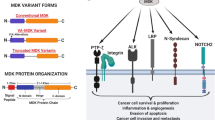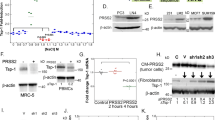Abstract
N-formyl peptide receptors (FPR1, FPR2 and FPR3) are involved in innate immunity, inflammation and cancer. FPR expression, initially described in immune cells, was later observed in non-hematopoietic cell populations and tissues. Several studies suggested a role for FPRs in the progression of various tumor histotypes, including gastric cancer (GC), for which a positive association with a specific FPR1 polymorphism has recently been described. We previously showed that FPRs are expressed on gastric epithelium and are required for wound repair and restitution of barrier integrity. Here we assess the role of FPRs in GC. We characterized the functions of FPRs in GC epithelial cells (MKN28, AGS and MKN45) cultured in vitro by assessing migration, proliferation, resistance to apoptosis and activation of the epithelial-to-mesenchymal transition. Activation of each FPR induced the epithelial-to-mesenchymal transition, proliferation, resistance to apoptosis and migration of GC cells in culture. Blocking compounds or RNA interference of each FPR reverted these effects. We also defined the in vivo tumorigenic potential of GC epithelial cells silenced for FPRs by xenograft experiments in immunocompromised mice. Interestingly, FPR1 silencing in GC cells (shFPR1) significantly enhanced xenograft growth with respect to shCTR, shFPR2 and shFPR3 xenografts, because of augmented vessel density and cell proliferation. Accordingly, HIF-1α and VEGF mRNA levels were higher in shFPR1 xenografts than in controls. Moreover, the in vitro production of proangiogenic factors in response to FPR2/3 agonists (WKYMVm, LL-37, uPA, uPAR84-95, AnxA1) or to other proinflammatory mediators (IL-1α) was higher in shFPR1 GC cells than in shCTR, shFPR2 and shFPR3 cells, suggesting that FPR1 functions as an inhibitor of CG angiogenesis. Thus, we propose that FPR1 stimulation may represent a novel therapeutic approach to counteract tumor angiogenesis.
This is a preview of subscription content, access via your institution
Access options
Subscribe to this journal
Receive 50 print issues and online access
$259.00 per year
only $5.18 per issue
Buy this article
- Purchase on Springer Link
- Instant access to full article PDF
Prices may be subject to local taxes which are calculated during checkout









Similar content being viewed by others
References
Ye RD, Boulay F, Wang JM, Dahlgren C, Gerard C, Parmentier M et al. International Union of Basic and Clinical Pharmacology. LXXIII. Nomenclature for the formyl peptide receptor (FPR) family. Pharmacol Rev 2009; 61: 119–161.
Le Y, Murphy PM, Wang JM . Formyl-peptide receptors revisited. Trends Immunol 2002; 23: 541–548.
de Paulis A, Prevete N, Fiorentino I, Walls AF, Curto M, Petraroli A et al. Basophils infiltrate human gastric mucosa at sites of Helicobacter pylori infection, and exhibit chemotaxis in response to H. pylori-derived peptide Hp(2-20). J Immunol 2004; 172: 7734–7743.
de Paulis A, Montuori N, Prevete N, Fiorentino I, Rossi FW, Visconte V et al. Urokinase induces basophil chemotaxis through a urokinase receptor epitope that is an endogenous ligand for formyl peptide receptor-like 1 and -like 2. J Immunol 2004; 173: 5739–5748.
Gao JL, Guillabert A, Hu J, Le Y, Urizar E, Seligman E et al. F2L, a peptide derived from heme-binding protein, chemoattracts mouse neutrophils by specifically activating Fpr2, the low-affinity N-formylpeptide receptor. J Immunol 2007; 178: 1450–1456.
Migeotte I, Communi D, Parmentier M . Formyl peptide receptors: a promiscuous subfamily of G protein-coupled receptors controlling immune responses. Cytokine Growth Factor Rev 2006; 17: 501–519.
Pott J, Hornef M . Innate immune signalling at the intestinal epithelium in homeostasis and disease. EMBO Rep 2012; 13: 684–698.
de Paulis A, Prevete N, Rossi FW, Rivellese F, Salerno F, Delfino G et al. Helicobacter pylori Hp(2-20) promotes migration and proliferation of gastric epithelial cells by interacting with formyl peptide receptors in vitro and accelerates gastric mucosal healing in vivo. J Immunol 2009; 183: 3761–3769.
Babbin BA, Jesaitis AJ, Ivanov AI, Kelly D, Laukoetter M, Nava P et al. Formyl peptide receptor-1 activation enhances intestinal epithelial cell restitution through phosphatidylinositol 3-kinase-dependent activation of Rac1 and Cdc42. J Immunol 2007; 179: 8112–8121.
Shao G, Julian MW, Bao S, McCullers MK, Lai JP, Knoell DL et al. Formyl peptide receptor ligands promote wound closure in lung epithelial cells. Am J Respir Cell Mol Biol 2011; 44: 264–269.
Zhang XG, Hui YN, Huang XF, Du HJ, Zhou J, Ma JX . Activation of formyl peptide receptor-1 enhances restitution of human retinal pigment epithelial cell monolayer under electric fields. Invest Ophthalmol Vis Sci 2011; 52: 3160–3165.
Zhou Y, Bian X, Le Y, Gong W, Hu J, Zhang X et al. Formylpeptide receptor FPR and the rapid growth of malignant human gliomas. J Natl Cancer Inst 2005; 97: 823–835.
Huang J, Chen K, Chen J, Gong W, Dunlop NM, Howard OM et al. The G-protein-coupled formyl peptide receptor FPR confers a more invasive phenotype on human glioblastoma cells. Br J Cancer 2010; 102: 1052–1060.
Chen K, Liu M, Liu Y, Yoshimura T, Shen W, Le Y et al. Formyl peptide receptor-2 contributes to colonic epithelial homeostasis, inflammation, and tumorigenesis. J Clin Invest 2013; 123: 1694–1704.
Otani T, Ikeda S, Lwin H, Arai T, Muramatsu M, Sawabe M . Polymorphisms of the formylpeptide receptor gene (FPR1) and susceptibility to stomach cancer in 1531 consecutive autopsy cases. Biochem Biophys Res Commun 2011; 405: 356–361.
Seifert R, Wenzel-Seifert K . Defective Gi protein coupling in two formyl peptide receptor mutants associated with localized juvenile periodontitis. J Biol Chem 2001; 276: 42043–42049.
Thiery JP . Epithelial-mesenchymal transitions in development and pathologies. Curr Opin Cell Biol 2003; 15: 740–746.
Radisky ES, Radisky DC . Matrix metalloproteinase-induced epithelial-mesenchymal transition in breast cancer. J Mammary Gland Biol Neoplasia 2010; 15: 201–212.
Kalluri R, Weinberg RA . The basics of epithelial-mesenchymal transition. J Clin Invest 2009; 119: 1420–1428.
de Paulis A, Ciccarelli A, de Crescenzo G, Cirillo R, Patella V, Marone G . Cyclosporin H is a potent and selective competitive antagonist of human basophil activation by N-formyl-methionyl-leucyl-phenylalanine. J Allergy Clin Immunol 1996; 98: 152–164.
Prevete N, Staiano RI, Granata F, Detoraki A, Necchi V, Ricci V et al. Expression and function of Angiopoietins and their tie receptors in human basophils and mast cells. J Biol Regul Homeost Agents 2013; 27: 827–839.
Pang M, Ma L, Gong R, Tolbert E, Mao H, Ponnusamy M et al. A novel STAT3 inhibitor, S3I-201, attenuates renal interstitial fibroblast activation and interstitial fibrosis in obstructive nephropathy. Kidney Int 2010; 78: 257–268.
Kalia S, Bansal MP . Diethyl maleate-induced oxidative stress leads to testicular germ cell apoptosis involving Bax and Bcl-2. J Biochem Mol Toxicol 2008; 22: 371–381.
D'Acquisto F, Perretti M, Flower RJ . Annexin-A1: a pivotal regulator of the innate and adaptive immune systems. Br J Pharmacol 2008; 155: 152–169.
Paul SA, Simons JW, Mabjeesh NJ . HIF at the crossroads between ischemia and carcinogenesis. J Cell Physiol 2004; 200: 20–30.
Cheng TY, Wu MS, Lin JT, Lin MT, Shun CT, Huang HY et al. Annexin A1 is associated with gastric cancer survival and promotes gastric cancer cell invasiveness through the formyl peptide receptor/extracellular signal-regulated kinase/integrin beta-1-binding protein 1 pathway. Cancer 2012; 118: 5757–5767.
Devosse T, Dutoit R, Migeotte I, DE Nadai P, Imbault V, Communi D et al. Processing of HEBP1 by cathepsin D gives rise to F2L, the agonist of formyl peptide receptor 3. J Immunol 2011; 187: 1475–1485.
Leoni G, Alam A, Neumann PA, Lambeth JD, Cheng G, McCoy J et al. Annexin A1, formyl peptide receptor, and NOX1 orchestrate epithelial repair. J Clin Invest 2013; 123: 443–454.
Jing YY, Han ZP, Sun K, Zhang SS, Hou J, Liu Y et al. Toll-like receptor 4 signaling promotes epithelial-mesenchymal transition in human hepatocellular carcinoma induced by lipopolysaccharide. BMC Med 2012; 10: 98–109.
Cooray SN, Gobetti T, Montero-Melendez T, McArthur S, Thompson D, Clark AJ et al. Ligand specific conformational change of the G-protein coupled receptor ALX/FPR2 determines proresolving functional responses. Proc Natl Acad Sci USA 2013; 110: 18232–18237.
Takahashi A, Kono K, Itakura J, Amemiya H, Feng Tang R, Iizuka H et al. Correlation of vascular endothelial growth factor-C expression with tumor-infiltrating dendritic cells in gastric cancer. Oncology 2002; 62: 121–127.
Liu L, Ma XL, Xiao ZL, Li M, Cheng SH, Wei YQ . Prognostic value of vascular endothelial growth factor expression in resected gastric cancer. Asian Pac J Cancer Prev 2012; 13: 3089–3097.
Cheng WL, Wang CS, Huang YH, Tsai MM, Liang Y, Lin KH . Overexpression of CXCL1 and its receptor CXCR2 promote tumor invasion in gastric cancer. Ann Oncol 2011; 22: 2267–2276.
Avilla E, Guarino V, Visciano C, Liotti F, Svelto M, Krishnamoorthy G et al. Activation of TYRO3/AXL tyrosine kinase receptors in thyroid cancer. Cancer Res 2011; 71: 1792–1804.
Detoraki A, Staiano RI, Granata F, Giannattasio G, Prevete N, de Paulis A et al. Vascular endothelial growth factors synthesized by human lung mast cells exert angiogenic effects. J Allergy Clin Immunol 2009; 123: 1142–1149.
Acknowledgements
We are grateful to Jean Ann Gilder (Scientific Communication srl., Naples, Italy) for editing the text. This work was supported by grants from Ministero della Salute (Ricerca Finalizzata 2009 - IZSM RF 2009), Regione Campania CISI-Lab Project, CRÈME Project and TIMING Project.
Author information
Authors and Affiliations
Corresponding author
Additional information
Supplementary Information accompanies this paper on the Oncogene website
Supplementary information
Rights and permissions
About this article
Cite this article
Prevete, N., Liotti, F., Visciano, C. et al. The formyl peptide receptor 1 exerts a tumor suppressor function in human gastric cancer by inhibiting angiogenesis. Oncogene 34, 3826–3838 (2015). https://doi.org/10.1038/onc.2014.309
Received:
Revised:
Accepted:
Published:
Issue Date:
DOI: https://doi.org/10.1038/onc.2014.309
This article is cited by
-
From odor to oncology: non-canonical odorant receptors in cancer
Oncogene (2024)
-
Role and mechanism of benzo[a]pyrene in the transformation of chronic obstructive pulmonary disease into lung adenocarcinoma
Journal of Cancer Research and Clinical Oncology (2023)
-
PD-1 blockade delays tumor growth by inhibiting an intrinsic SHP2/Ras/MAPK signalling in thyroid cancer cells
Journal of Experimental & Clinical Cancer Research (2021)
-
Pivotal Role of Peptides in Gastric Carcinoma: Diagnosis and Therapy
International Journal of Peptide Research and Therapeutics (2021)
-
Nanoantibiotics containing membrane-active human cathelicidin LL-37 or synthetic ceragenins attached to the surface of magnetic nanoparticles as novel and innovative therapeutic tools: current status and potential future applications
Journal of Nanobiotechnology (2020)



